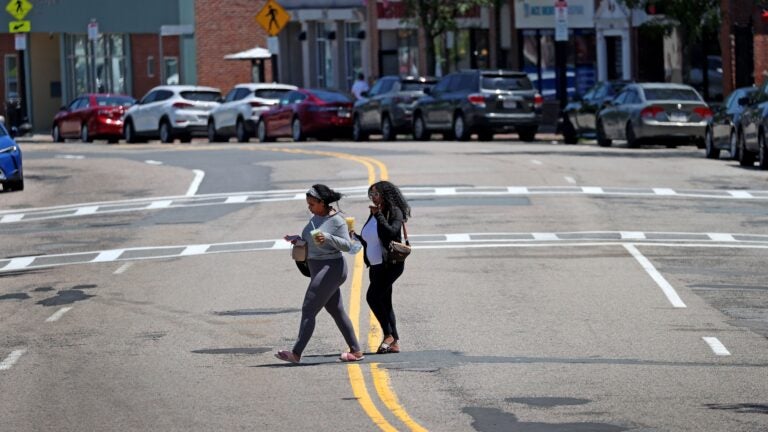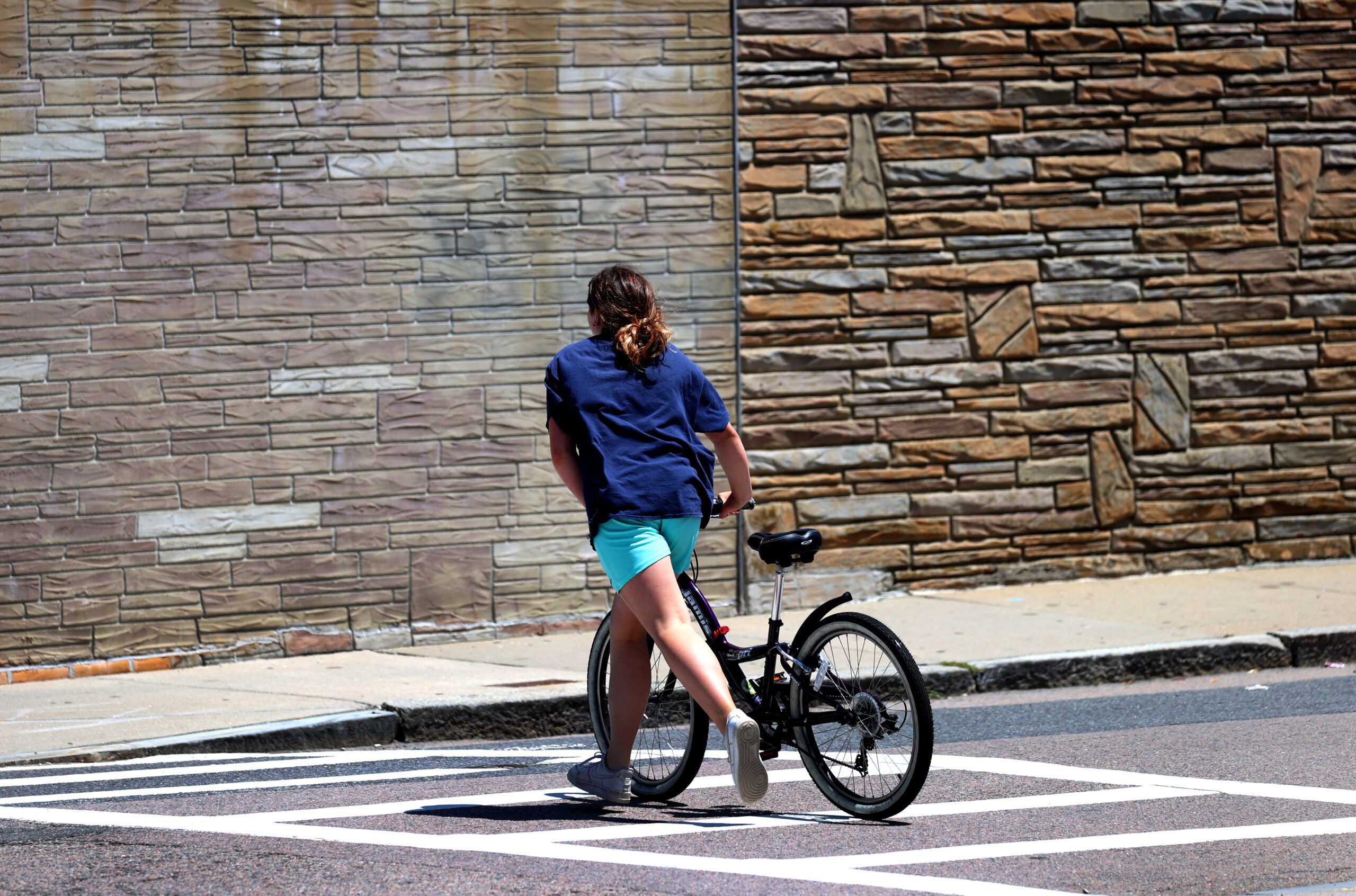On West Roxbury’s Centre Street, a city plan to reduce traffic lanes divides the community
 Things are rarely so quiet for pedestrians on Centre Street in West Roxbury, where speeding cars are a problem. David L. Ryan/Globe Staff
updated on July 7, 2023
Things are rarely so quiet for pedestrians on Centre Street in West Roxbury, where speeding cars are a problem. David L. Ryan/Globe Staff
updated on July 7, 2023
By the end of this year, Centre Street in West Roxbury will be transformed. Whether that transformation will be for the better is a topic of debate that has deeply polarized the neighborhood for four years.
The Centre Street Design Project, a city plan unveiled on May 31[2], will slim the notoriously perilous thoroughfare from four lanes down to three between LaGrange Street and West Roxbury Parkway and add parking-protected bike lanes. City officials say the redesign will improve safety for pedestrians, motorists, and bicyclists alike, in line with Mayor Michelle Wu’s citywide Safety Surge program[3], as well as make the transit artery into a lively, neighborhood street.
Advertisement:But the supposed win-win proposal has drawn fierce backlash from a vocal subset of residents, who fear the so-called road diet will further imperil residents, increase traffic, and harm local businesses. It’s the latest example of tension[4] in Boston that has pitted urban planners, who aim to reduce pedestrian injuries and make streets more walkable and bikeable, against residents who say the city is not listening to their desires.
“It’s not the community’s plan. We do not want it,” said Stephen Morris, cofounder of the West Roxbury Safety Committee, a citizens group that has organized against the plan. “What the community wants should be what the government does.”
Centre Street, West Roxbury’s main thoroughfare and business corridor, has been the site of many crashes and injuries in recent years. In February 2019, a woman was killed while crossing[5] the Centre and Hastings streets intersection, spurring the city to implement revised signage and in-street pedestrian crossing signs. Since then, nine pedestrians have been struck and injured on the street, according to the Boston Vision Zero Injury Crash Map. Last winter, a kindergartner walking home from school had his foot run over by a car running a red light.
Advertisement:On weekdays, the majority of the roughly 15,000 vehicles that traverse Centre Street daily exceed the 25-miles-per-hour speed limit, according to January 2022 data from the Boston Transportation Department.[6] By Lagrange Street, 15 percent of drivers go 35 miles per hour, a fatal speed for older pedestrians, the data show, and Centre Street’s crash rate over the past few years is 34 percent higher than the statewide average for similar thoroughfares.
Even the plan’s staunchest opponents agree that Centre Street is unsafe.
“Sometimes at nighttime or every morning, this looks like Interstate 95. People go, like, 50 miles an hour,” said Dimitri Meleplidis, who owns Maria’s Kitchen on Centre Street and opposes the plan. “So definitely something needs to be done about that.”
The question of how to improve pedestrian safety, however, is where the camps diverge.
Some West Roxbury residents, worried that lane reduction will increase traffic and cause gridlock, have advocated for alternative measures to draw more attention to vulnerable pedestrians without changing the road’s configuration, such as longer walk signals, more signalized intersections, and an increased police presence to reprimand speeders.
But the city’s urban planners say those fixes are not enough to correct Centre Street’s safety hazards. Four-lane streets are “a fundamentally dangerous configuration,” said Jascha Franklin-Hodge, the city’s chief of streets.
Advertisement:On a four-lane road with no designated turning lane, drivers turning left have to worry about two lanes of oncoming traffic, cars queuing up behind them, and pedestrians potentially crossing the side street they’re turning onto, Franklin-Hodge said.
“When you give drivers a complex environment with that many points of conflict to think about, it is a recipe for crashes,” he said.
The new street design will preserve one travel lane in each direction and add a third “flex” lane in the middle, which will serve as a designated left-turn lane near intersections. The plan will also preserve 95 percent of the current on-street parking spots along the corridor, according to the city. Even though the roadway will be slimmed by a quarter, its capacity for cars will not change, Franklin-Hodge said.
“There is actually a very minimal impact when you reduce the lane, because . . . you end up creating a much more organized flow of vehicles on the street,” he said, adding that road diets are a “very common practice” that has been endorsed by federal and state transportation agencies.
But the West Roxbury Safety Committee and its supporters doubt the city’s claims, and some have expressed skepticism that the plan would really cut parking spots by only 5 percent. Instead, many opponents see evidence of an ulterior motive: the government capitulating to bicyclists.
“All the studies that I’ve seen that are talking about improved safety or less traffic, they end in dot-gov or they’re from some advisory firm that is making money,” Morris said. “Their real intent was to satisfy the bicyclists union and not be concerned with safety or improving safety on Centre Street.”
Advertisement: A bicyclist used a crosswalk by Centre Street, an area where there’s controversy over slimming the street from four lanes to three and adding a bike lane. DAVID L. RYAN/GLOBE STAFF
A bicyclist used a crosswalk by Centre Street, an area where there’s controversy over slimming the street from four lanes to three and adding a bike lane. DAVID L. RYAN/GLOBE STAFF
Bicyclists are “in large part not residents — they don’t patronize businesses,” said Joanne McGrath, a resident of West Roxbury since 1962. “They just want to ride through for six months out of the year.”
The city maintains that the plan’s main objective is improving pedestrian safety, not adding bike lanes.
“The bike lanes are a side benefit,” Councilor Kendra Lara, who represents West Roxbury, said last month. “When we remove [travel lanes] it gives us the opportunity to have parking-protected bike lanes, and so they’re going in, but the bike lanes are absolutely secondary.”
The neighborhood group’s current opposition mirrors a campaign it mounted in 2019[7] against a similar proposal by the Martin J. Walsh administration. After circulating a petition that garnered over a thousand signatures, the group successfully cajoled city officials into scrapping the road diet. Instead, the city installed brightly painted crosswalks and promised to increase enforcement in the area.
Not everyone in West Roxbury shares the group’s concerns.
Krissy Peterson, whose daughter attends the Patrick Lyndon Pilot School off Centre Street, said she’s “always worried” that drivers won’t see her child while she’s crossing the street and is excited for the peace of mind the redesign may bring. Peterson said she hasn’t noticed any “particular opposition” toward the redesign in her conversations with other parents, and finds it “frustrating” that the neighborhood backlash has adopted an “us against them rhetoric.”
Still, the campaign this year against the proposal has gained significant traction in the neighborhood: Hundreds of people have signed a new petition and more than a few businesses have red “Save Centre Street” signs in their windows. It has even received some backing from Councilor at Large Erin Murphy, who released a statement denouncing the redesign.
Advertisement:But despite the backlash, city officials say the plan is a done deal this time around.
“There are few cases where the data is so abundantly clear . . . and this is one of them,” Franklin-Hodge said. “So we are moving ahead with the project but integrating the feedback that we’ve been getting from community members.”
 The plan is to cut down to two lanes, with an additional lane for flexibility. DAVID L. RYAN/GLOBE STAFF
The plan is to cut down to two lanes, with an additional lane for flexibility. DAVID L. RYAN/GLOBE STAFF
The final design is expected to be completed in mid-July and construction will occur between October and early November, according to the city. The area will be monitored for any unintended effects, such as increased traffic on adjacent cut-through streets, the city said.
Still, the neighborhood committee believes it has a chance to block the measure, and its members are discussing their next move, Morris said. And if and when the plan does go through, Morris said, there will be political repercussions.
“I would expect that an electorate that feels like it’s not being listened to would not elect the person that’s not listening,” he said. “I personally would be remembering that at the voting booth.”
References
- ^ The Boston Globe (www.boston.com)
- ^ a city plan unveiled on May 31 (www.boston.gov)
- ^ Mayor Michelle Wu’s citywide Safety Surge program (www.bostonglobe.com)
- ^ It’s the latest example of tension (www.bostonglobe.com)
- ^ a woman was killed while crossing (www.bostonglobe.com)
- ^ January 2022 data from the Boston Transportation Department. (www.boston.gov)
- ^ mirrors a campaign it mounted in 2019 (www.bostonglobe.com)